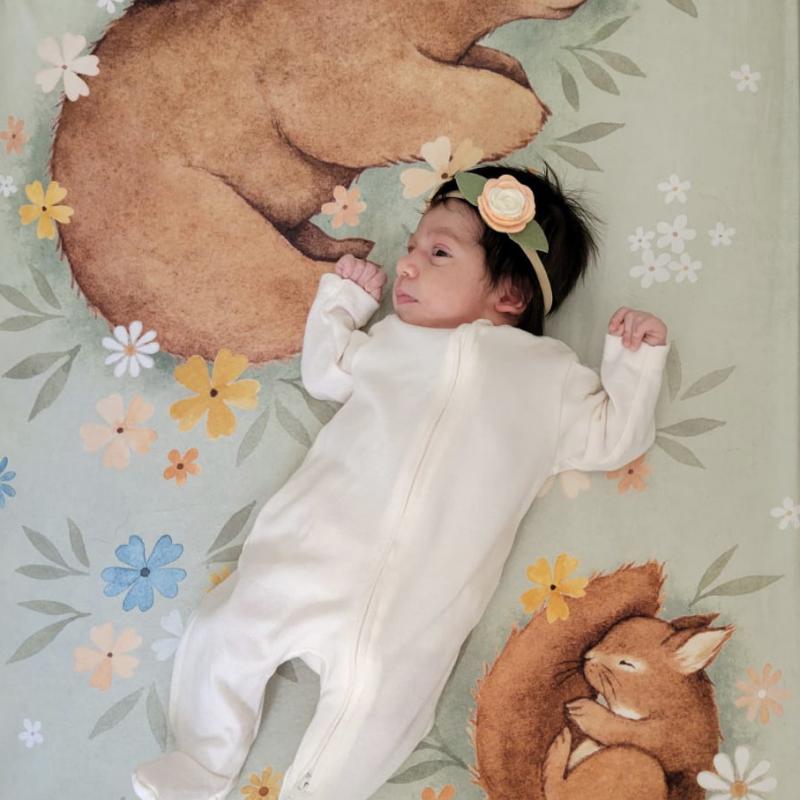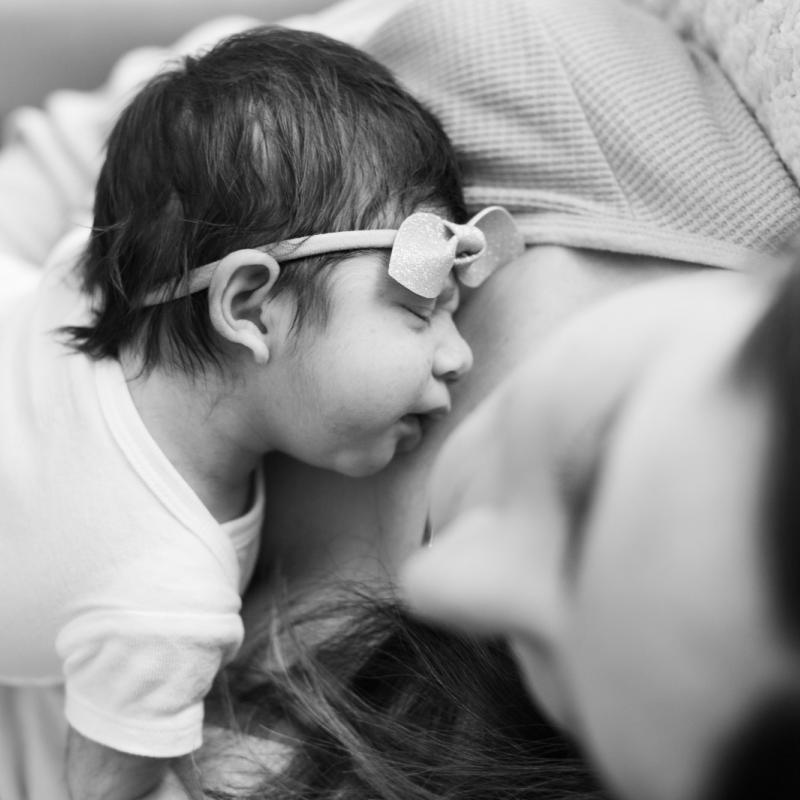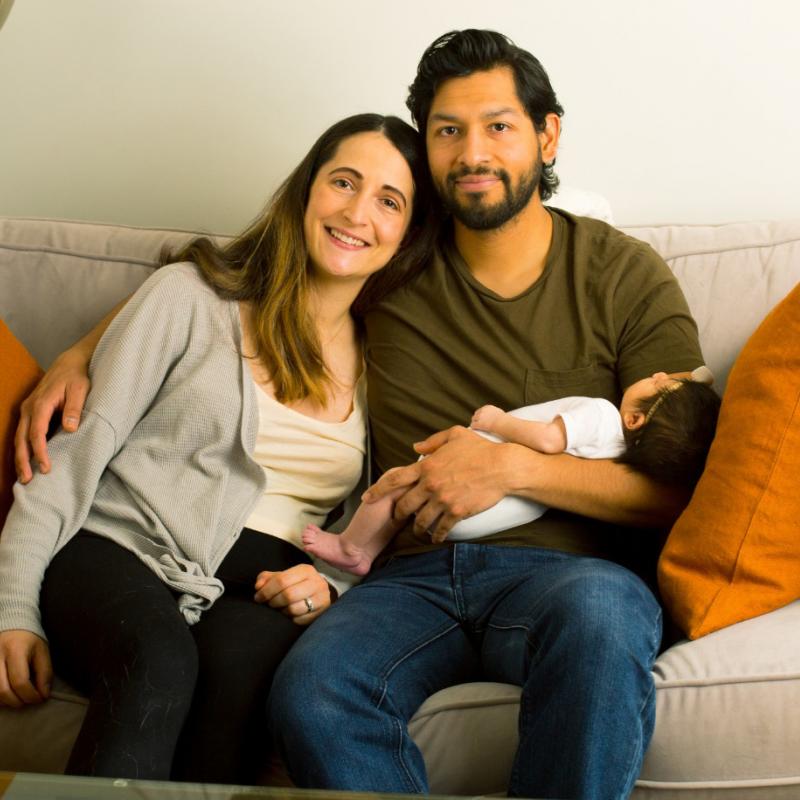As a genetic counsellor in the prenatal diagnosis department at Toronto’s Mount Sinai Hospital, Stephanie Telesca spends her days with the rarest of the rare. The ones in a million. The prospective parents who agonize over devastating news and life-altering decisions instead of selecting gifts for registries and preparing for baby showers. The ones who are left to cry and grieve what will never be instead of sharing photos of sleepy, swaddled newborns on social media.
It’s a job Ms. Telesca, Artsci’09, cares deeply about. But being exposed to traumatic, heartbreaking situations on a regular basis made her question whether she could bear the uncertainty that comes with the decision to start a family. In the end, the logical side – the one telling her that most pregnancies have happy endings – won, even if she couldn’t shake the worried feeling in the pit of her stomach. So, she and her husband, Christopher Espana, decided to take the leap.
Always a planner, Ms. Telesca was determined that she and Mr. Espana would undergo every available screening test before and during pregnancy. Everything looked great and they welcomed a baby girl, Eliana, on Feb. 27, 2021.
They had no way of knowing that Ms. Telesca’s worst fears – having a child with a severe disability and being given no warning or time to prepare – had come true. Within weeks of the birth, Ms. Telesca began to suspect something was amiss: Eliana always seemed to be crying and in pain, never made eye contact, and failed to reach other early developmental milestones.
A few months before her first birthday, Eliana was diagnosed with KCNC1-related developmental and epileptic encephalopathy (DEE), a potassium channel disorder that can cause intellectual and developmental delays, seizures and movement disorders, vision problems, and low muscle tone.
A cruel twist of fate – a chance mutation on Eliana’s KCNC1 gene, which plays a pivotal role in communication between brain cells – had erased the future they had been waiting for and robbed Eliana of the life she deserved. It’s a condition so rare that it couldn’t have been detected on any prenatal genetic test. There were so few cases – only a handful are known – that Ms. Telesca and Mr. Espana struggled even to find information about KCNC1-related DEE after Eliana’s diagnosis.
Now, at two years old, Eliana can’t hold her head up, feed herself, or speak. She smiles when she hears her mother’s voice – but she will never look into her mother’s eyes, or stumble clumsily as she masters her first steps. While other children her age are busy emptying kitchen cupboards, learning new words, and exploring their world, Eliana remains, in many ways, an infant. She can’t ever be left unsupervised and is largely immobile. And, as she gets older, it’s becoming harder to provide basic care for her. For instance, bath time is a struggle, as Eliana’s low muscle tone and inability to hold herself up make it hard for her parents to safely lift her in and out of the tub.
“Every aspect of life is difficult,” says Ms. Telesca, who lives in Toronto. “It’s hard to say exactly how difficult it is.”
But in the midst of her struggle and heartbreak, Ms. Telesca has also found a new purpose: fighting for a brighter future for Eliana. And that means using her knowledge of the medical system and expert navigational skills to help find a treatment that can hopefully reduce the severity of some of Eliana’s symptoms and give the little girl a better chance at life.
Ms. Telesca and her husband have created a foundation, the KCNC1 Foundation, to help raise money to research cures and treatments for KCNC1-related DEE and other similar genetic disorders.
"Every aspect of life is difficult," says Ms. Telesca… but in the midst of her struggle and heartbreak, [she] has also found a new purpose: fighting for a brighter future for Eliana.
“I obviously didn’t choose to have a child with a disability, but this is what happened,” Ms. Telesca says. “As a parent, you’re going to do whatever you can to give them a good life.”
There is no known cure for KCNC1-related DEE. Combinations of drugs, such as anti-seizure medications, along with physical and occupational therapy, can help with some symptoms. But its rarity means little research has been done on this genetic condition, which has been another source of frustration for Ms. Telesca and her family.
As she and her husband learned, the world of rare diseases is marked by patients who often feel overlooked or abandoned by the medical system. Because of the small number of cases, rare diseases can be difficult to study. And, historically, pharmaceutical companies have had little financial incentive to invest vast sums into rare-disease research, given the chance of a return on investment is relatively small.
But there is a growing network of clinicians and families who are finding novel ways to treat certain rare genetic diseases. Ms. Telesca hopes this avenue will yield results for Eliana. She made contact with Ethan Perlstein, the founder of a biotechnology company in San Francisco that is dedicated to finding treatments for rare diseases like Eliana’s. Instead of developing entirely new drugs – a time-consuming and extremely expensive undertaking – the company funds research and clinical trials that use existing drugs to see if they can be repurposed to treat certain genetic conditions.
It’s an exciting new pathway for families of children with rare diseases and has become a lifeline for Ms. Telesca, who sees enormous potential in finding an existing drug and seeing how it can be used to treat the symptoms of KCNC1-related DEE.
The very fact that there’s a company solely focused on the mission of helping to find treatments for rare diseases is enough to be excited about, as conditions like Eliana’s are often neglected and receive relatively scant attention in the world of scientific research.
“It’s really nice and really uplifting to see so many people working together to help children with rare diseases,” she says.
Ms. Telesca is focused on helping to fund research into finding a drug that can be repurposed to help treat Eliana’s condition. She’s heard about cases of other children with disorders in the same family who are seeing some success with repurposed drugs and is hopeful about the possibilities.
After receiving and coming to terms with Eliana’s diagnosis, [Ms. Telesca] and her husband started to make connections with other families of children with complex medical needs, including those with rare diseases.
While a cure would be a miracle, Ms. Telesca and her husband are steadfastly focused on finding a treatment that can help Eliana gain more control over her body and mind, making it easier for her to navigate through life.
“We just always wanted her to be able to decide how she lives her life. We hope that we find a treatment that allows her more bodily autonomy,” Ms. Telesca says.
Of course, it’s not easy to gain access to new treatments and experimental therapies. So, that means Ms. Telesca has had to become an expert at navigating the complex global network of researchers, scientists, and pharmaceutical companies who are trying to help patients with rare diseases. She and her husband recently started working with Metrion Biosciences, a company based in the United Kingdom, to look for a possible medication that could be repurposed to help Eliana. Ms. Telesca has connected with universities, researchers, and parents around the world in her quest to help her daughter.
In the process, she has also found something she needed: a community. For months after Eliana was born, Ms. Telesca found herself housebound and unable to complete the basic tasks of daily living, as exhaustion and anxiety took over. After receiving and coming to terms with Eliana’s diagnosis, she and her husband started to make connections with other families of children with complex medical needs, including those with rare diseases. She started taking her daughter to a community centre designed for children with special needs and marvelled at the ability to speak out loud about the struggles she and her husband face with other parents who understand.
“It was my reintroduction into civil society,” she says.
And it was in this new community that she also learned to appreciate the limited ways her daughter can communicate and play. For instance, Eliana’s therapists frame her frequent bouts of crying as an excellent way of communicating that something is wrong. And they’ve helped Ms. Telesca see how fussy Eliana gets when her mother is speaking to someone else. They’re a small window into Eliana’s world and her parents are grateful for them.
To many people in her life, what Ms. Telesca is doing is nothing short of remarkable: juggling full-time work with caring for her daughter and carving out a space in the world of pharmaceutical biotechnology for an ultra-rare disease. But to her, this is the only option.
“There is no other door for me,” she says. “This is how I keep going.”
Ms. Telesca can trace her fierce commitment and determination to her time as a student at Queen’s. She recalls being surrounded by people who were accomplishing so much and working so hard to better themselves and their communities.
“I think just being around that has fostered … my motivation to get things done and wanting to see things in a better light,” she says. “I think being at Queen’s was very integral in shaping the person I am today.”
Like any parents, Ms. Telesca and her husband have hopes and dreams for their daughter. It’s just that they look a little different than those of her peers. For them, the dream is finding a way to give Eliana the chance to control the movements of her body, experience joy and love, and express her thoughts, wants, and feelings.
“We feel pretty hopeful that we’ll find something,” she says. “How quickly, we’re not sure.”
What are the odds?
Many rare diseases are exceedingly uncommon – one in a million, or even less. Some affect only a few people on the entire planet. There are between 6,000 and 8,000 different rare diseases – estimates vary – and collectively, they affect a lot of people. Many are life-threatening, but even those that aren’t can have a major impact on quality of life.
In 2021, Health Canada published a discussion paper, Building a National Strategy for High-Cost Drugs for Rare Diseases.
It outlines some of the unique challenges that rare diseases present. According to that paper, fewer than 10 per cent of these conditions have any kind of treatment. Recent years have seen an increase in treatments that cost more than $200,000 per patient, per year. And some treatments can cost 10 times that.
Pharmaceutical companies attribute the large price tags to the high cost of research and development, and the small market size for any one condition. And because of these costs, access to treatments can be patchy. Government and private drug plans won’t always pay, and the price is too high for most people to pay out of pocket.
But there are other challenges, too. Roughly 80 per cent of rare diseases are genetic, and it is often possible to diagnose them with pre-natal genetic screening. However, when not caught early, diagnostic errors are more likely. Attending physicians are unlikely to have seen a rare disease’s symptoms before, making it much more difficult to successfully diagnose.






